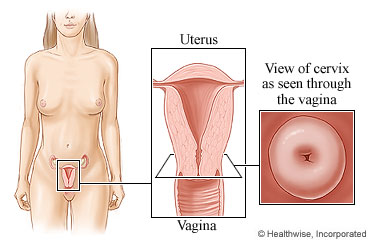
What is LEEP?
A loop electrosurgical excision procedure (LEEP) removes tissue from the cervix. You may have this done if you've had a Pap test or colposcopy that shows tissue that isn't normal.
During LEEP, your doctor will put a tool called a speculum into your vagina. It opens the vagina a little bit. This lets your doctor see the cervix and inside the vagina. A special fluid is sometimes put on your cervix to make certain areas easier to see.
You may get a shot of medicine to numb the cervix. You may feel cramps when you have the shot. You may also get pain medicine.
Your doctor will put a device with a fine wire loop into your vagina. The doctor uses the heated wire to cut out tissue. After the procedure, another doctor will look at the tissue under a microscope and check it for abnormal cells.
You may have mild cramps for several hours after LEEP. A dark brown discharge during the first week is normal. You may have some spotting for about 3 weeks.
LEEP is done in a doctor's office, a clinic, or a hospital. It takes only a few minutes. You can go home after the procedure.
You can probably return to your normal routine in about a week. How long it takes you to recover will depend on how much was done.
How do you prepare for the procedure?
Procedures can be stressful. This information will help you understand what you can expect. And it will help you safely prepare for your procedure.
 Preparing for the procedure
Preparing for the procedure
- Tell your doctor if:
- You are having your menstrual period.
- You are or might be pregnant. A blood or urine test may be done to see if you are pregnant.
- Understand exactly what procedure is planned, along with the risks, benefits, and other options.
- If you take a medicine that prevents blood clots, your doctor may tell you to stop taking it before your procedure. Or your doctor may tell you to keep taking it. (These medicines include aspirin and other blood thinners.) Make sure that you understand exactly what your doctor wants you to do.
- Tell your doctor ALL the medicines, vitamins, supplements, and herbal remedies you take. Some may increase the risk of problems during your procedure. Your doctor will tell you if you should stop taking any of them before the procedure and how soon to do it.
What happens on the day of the procedure?
- You may eat or drink as you normally do.
- You may want to take a pain reliever, such as ibuprofen (Advil or Motrin), 30 to 60 minutes before you have the procedure. This can help reduce any cramping pain.
At the doctor's office or hospital
-
Bring a picture ID.
-
You will be kept comfortable and safe by your anesthesia provider. You may get medicine that relaxes you. The area being worked on will be numb.
-
The procedure will take about 15 to 30 minutes.
When should you call your doctor?
- You have questions or concerns.
- You don't understand how to prepare for your procedure.
- You become ill before the procedure (such as fever, flu, or a cold).
- You need to reschedule or have changed your mind about having the procedure.
Where can you learn more?
Go to http://www.healthwise.net/patientEd
Enter L547 in the search box to learn more about "Loop Electrosurgical Excision Procedure (LEEP): Before Your Procedure".
Current as of: May 5, 2025
Author: Ignite Healthwise, LLC Staff
Clinical Review Board
All Ignite Healthwise, LLC education is reviewed by a team that includes physicians, nurses, advanced practitioners, registered dieticians, and other healthcare professionals.

